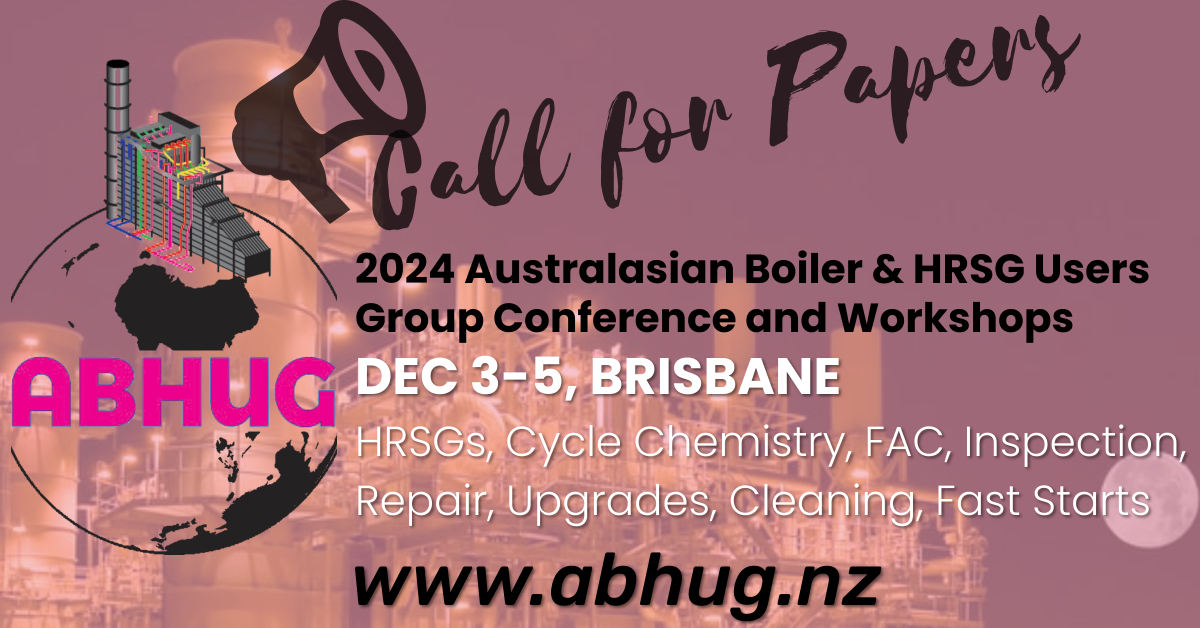By Steven C Stultz, Consulting Editor
The Australasian Boiler and HRSG Users Group will conduct its 2024 meeting in Brisbane, December 3 – 5. Details will be available at www.ccj-online.com as they become available. Submit your abstracts to present to Barry Dooley and Bob Anderson for consideration.
Steering committee
ABHUG is chaired by Barry Dooley, Structural Integrity Associates, and Bob Anderson, Competitive Power Resources. Steering committee members in addition to Dooley and Anderson are the following:
David Addision, Thermal Chemistry, New Zealand*
Russell Coade, HRL Technology Group, Australia*
Ivan Currie, EnergyAustralia, Australia**
Stuart Mann, AGL, Victoria**
Ian Rawlings, CS Energy, Australia**
Charles Thomas, Quest Integrity, New Zealand**
—————————————————————————————————-
* Consultant
** Energy provider
The IAPWS Australasian Boiler and HRSG Users Group (ABHUG) held its 2023 conference and workshops last November, in Brisbane, Australia. Participants joined from Australia, New Caledonia, New Zealand, Singapore, Switzerland, the UK, and the US. There were 26 technical presentations, two workshops, and 100 attendees.
Summarizing the annual event, Co-chair Barry Dooley, Structural Integrity, said: “The meeting provided a highly interactive forum for the presentation of new information and technology related to HRSGs and fossil boilers, case studies of plant issues and solutions, and for open discussion among plant users, equipment suppliers, and industry consultants. ABHUG provided a unique opportunity for plant users to discuss questions relating to all aspects of HRSGs and boiler operation with the industry’s international experts.”
Below are selected highlights.
Large-component replacement
Dan Gitsham, NewGen Power, updated attendees on its 330-MW combined cycle in Kwinana, Western Australia, providing power to the South West Interconnected System. This plant, commissioned in 2008, features a 180-MW Alstom gas turbine, 160-MW GE steam turbine, and Alstom triple-pressure HRSG with duct firing.
Gitsham focused on lessons learned from a major reheater module replacement in 2022.
Reheater (RH) tube breaks in 2016 led to tube inserts. Ongoing leaks called for tube plugging in 2017, and in 2018 a reheater tube row was disconnected. After Reheater 2 suffered a tube leak in 2020, plans were made for tube module replacement (Fig 1).
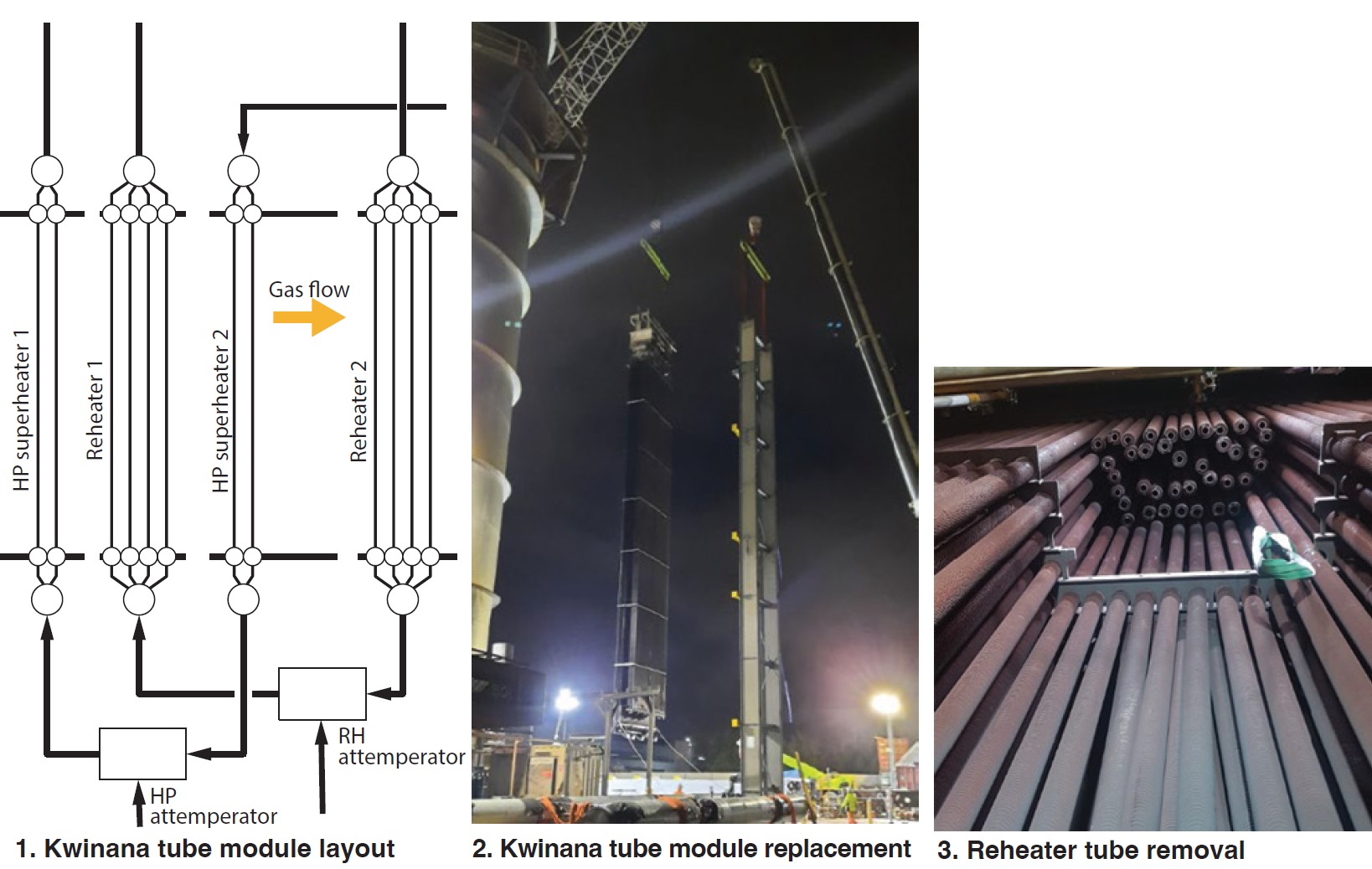
Modules were delivered in 2021 but the project was delayed because of Covid.
The 2022 outage was extensive in scope, including:
- HRSG tube module replacements (Fig 2).
- Partial replacement of RH2 module tubes (Fig 3).
- RH interstage attemperator spray loop redesign and replacement (Fig 4).
- Major inspection of high-energy piping (HEP).
- IP/LP steam turbine major.
- GT generator major.
- Replacement of generator rotor pole-to-pole connection.
- Modification of generator phase-ring connections.
- Main cooling-water pump replacement (seawater cooled).
- Major HV electrical protection testing.
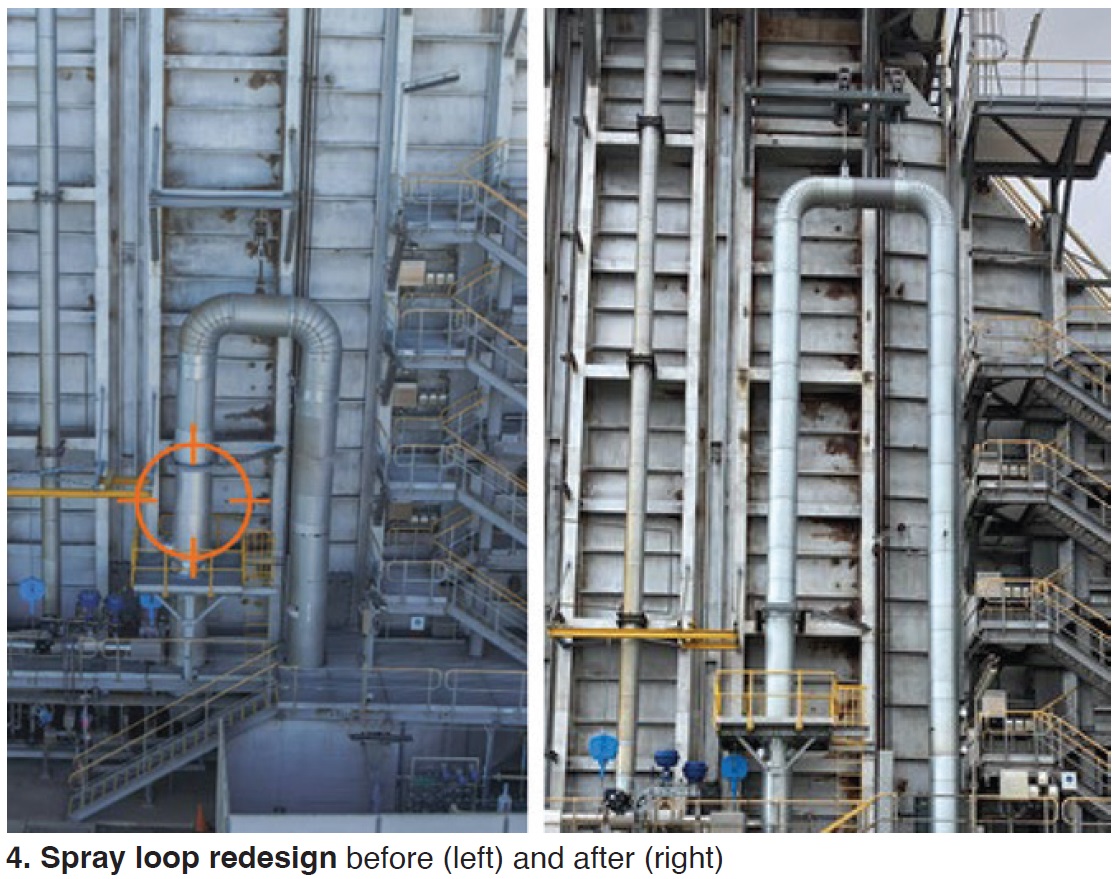
Project complete, Kwinana returned to full operation.
This presentation highlighted factors that should be included in any major outage planning (learn from the experience of others). The outage was extended from a planned 38 to actual 85 days. Selected reasons: lack of experienced people, some people simply “not showing up for work,” scaffolding contractor change needed two weeks into shutdown, difficulty finding quality welding supervisors, and rework with 22 nonconformances.
These details offer invaluable lessons and cautions for planning, with special thanks due for an honest project review—reinforcing the value of attending events like ABHUG 2024.
Thermal-transient updates
Co-chair Bob Anderson, Competitive Power Resources, provided updates on 68 combined-cycle plant surveys conducted globally over the past 15 years, plants of various configurations. Equipment covered 23 HRSG OEMs, five gas-turbine OEMs, 11 steam-turbine OEMs, various cooling systems, and “every possible type of cycle chemistry.”
As Barry Dooley explained, “This presentation offered international updates on HRSG thermal transient aspects associated with attemperators, condensate generation, superheater/reheater drain management, and steam-turbine bypass operation, revealing common (global) HRSG problems and issues.”
Anderson’s key tube-failure observations included the following:
- Causes of tube failures are not associated with a particular HRSG OEM.
- Most causes identified in 2008 remain active today.
- The frequency and impact ranking of tube-failure causes has not changed.
Supporting observations included:
- Very few failures are caused by a single event.
- Very few failures are attributed to creep damage.
- Failures are primarily associated with low-cycle fatigue (startup and shutdown).
He then offered the basic actions necessary to avoid repeat failures:
- Look for early symptoms of known causes and take prompt corrective actions.
- Remove the failure site for metallurgical analysis of the mechanism.
- Conduct a complete root-cause analysis (RCA); “fatigue is not a root cause.”
Only nine percent of the plants surveyed in 2023 (an increase from zero percent in 2009) had implemented a root-cause program. An important point: “Approval (time and money) to remove the failure location for analysis must be agreed by upper management before the failures occur.” Approval is the most common stumbling block.
For attemperator issues, routine hardware inspection programs showed an increase from 11% to 21% of plants, which is positive. But leaking spraywater still causes cracks in thermal liners and steam pipework. This high rate of damage, Anderson explained, is aggravated by “incorrect spray-valve sequence logic” where incorrect use of master control/martyr block valve logic quickly causes leak-through in both valves.
Drain design and performance, along with data monitoring, also remain critical issues in most plants surveyed.
Anderson traditionally offers this update with details at all related HRSG events (CCJ No. 75, p 71; CCJ No. 71, p 54).
Attemperator control, procedures
Said Dooley post-conference, “Several presentations on improved attemperator control and startup procedures described situations where an understanding of the process variables, steam flow, temperature, and pressure were able to assist in determining the root cause of failures.”
One primary presentation served as the opening technical discussion, namely Improved attemperator control and startup procedure to avoid overspray and overshooting of HPSH and RH outlet temperatures. This is the collective work of Anderson and Dave Buzza, American Electric Power (retired).
Content originated with a EPRI conference presentation by Buzza in 2018. Anderson and he drafted HRSG Fundamentals (Volume 4), Optimizing startup procedures and control logic for HP and reheat steam attemperators, for EPRI Program 218 in 2021 based on Buzza’s work.
One basis is heating-surface design. “If there is too much surface downstream of the attemperator (secondary) relative to upstream (primary) it is difficult to avoid overspray and avoid overshooting HPSH/RH outlet steam temperatures,” explained Anderson, adding that this design feature cannot be changed easily in existing units.
This foundation led to a suggested new startup procedure and case-study example. Maximizing steam flow during the startup is a key element of the procedure. A unique model-based attemperator control method developed by Buzza is also key to the procedure’s success. For details, see the recap of the 2023 European HRSG Forum (ninth annual conference) in CCJ No. 75, p 67.
Key features of the improved process include, but are not limited to, the following:
- Ensure HPSH and RH are properly drained.
- Use exhaust-temperature matching (if using a GE gas turbine).
- Maintain steam outlet temperature setpoint at unit rating.
- Establish stable steam flow path before loading the gas turbine through the “Hot Zone.”
- Increase GT load in small steps.
- Hold GT load steady for a few minutes until steam flow stabilizes.
- Increase GT load in one-megawatt steps.
- Hold GT load steady for a few minutes to allow steam flow to stabilize.
- Unit is now ready to ramp GT load through the Hot Zone.
Drain issues
Two presentations addressed drain issues.
Derek Pang and Jenni Pang of APA Group presented Recent learnings about erosion at APA. This focused on the energy company’s 244-MW Diamantina Power Complex in Queensland, the HP drains system, and problems associated with design and high-velocity erosion.
In one example, an incorrect valve installation was corrected to an isolation and shutoff arrangement and water accumulation was reduced by pipework changes.
Kalpesh Gharat, SRG Global, discussed Piping drain attachment failures associated with condensate from high-energy pipework. Inspections have centered around large branch welds and personnel safety concerns. Primary focus has been the pipe to drain pot branch weld.
Gharat reviewed all inspection techniques then zeroed-in on creep damage in the main branch attributed to stress, temperature and time (geometric stress). “Creep voids accumulate until microcracking initiates,” he explained. He also included examples of corrosion under insulation.
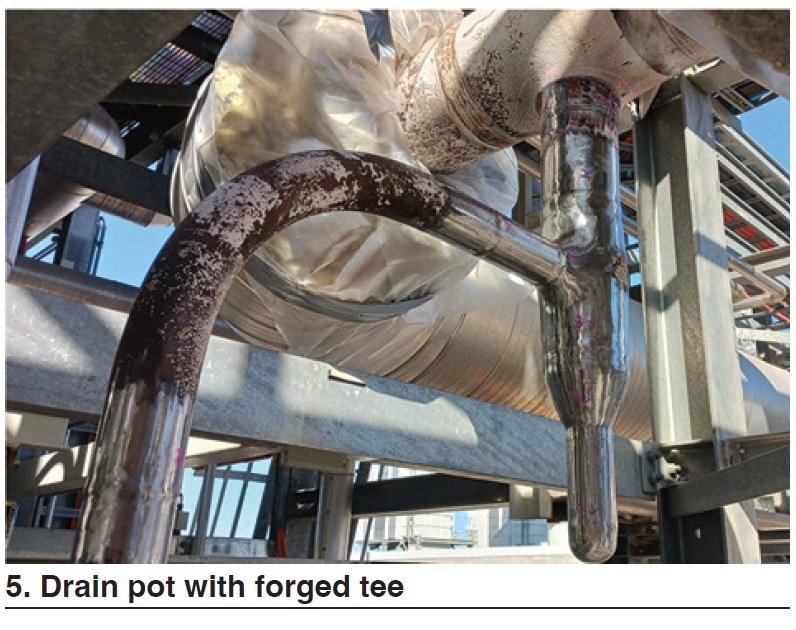
His summary:
- Drain-pot and drain-line repairs are relatively simple, provided there is no creep (Fig 5).
- Cut lines should be based on ultrasonic testing and thickness.
- Post-weld heat-treatment requirements depend on the material and its thickness.
- Depending on configuration and number of welds, repair may affect other areas of the drain pot.
-
- Post-weld heat treatment may affect other welds already impacted by creep.
- Bore cracking may impact the extent of repairs/replacement.
-
- Plants should stock billet material or pot sections for replacement if needed.
NDE/inspections workshop
One case study showed how low-frequency electromagnetic testing (LFET) could rapidly screen reheater tubes for internal corrosion pitting.
Benji Rhead, IrisNDT, and Jason Cruickshank, AGL Australia, discussed Inspection of reheater tubes using LFET to find standby corrosion. Their example was an increasing trend of standby corrosion at Loy Yang, a multi-unit lignite-fired power station in southeastern Victoria, Australia. Tube repairs attributed to standby corrosion first appeared in 2020 and increased dramatically in 2021.
Rhead explained that standby corrosion generally occurs when condensate is trapped in the boiler tubes while the boiler is out of service, leading to oxygen pitting. The detection method shown was a variation of eddy current technology using ultra-low frequencies in the range of 5 to 10 Hz.
LFET can be used on tubing or pipe ranging from 2.4 to 36 in. OD. Testing is from the outer diameter of either ferrous or non-ferrous tube or pipe to identify inner-diameter corrosion. LFET also can identify generalized losses such as flow-accelerated corrosion.
This is a non-contact, couplant-free method that can be effective through thin coatings. Equipment is portable and requires little or no surface preparation. LFET is primarily a screening tool for follow-up ultrasonic testing.

Another case study described the ultrasonic inspection of superheater inlet stubs with a custom-made UT probe (Fig 6). Andrew van Niekerk (AGL Energy) and Aron Abolis (SRG Global) presented Development of ultrasonic inspection for cracking in secondary superheater inlet stubs. The subject was stub failures at Bayswater and other New South Wales power stations, primarily large fossil-fueled units.
Cycle-chemistry workshop
Barry Dooley and David Addison, both members of the steering committee, gave international updates on HRSG and fossil-plant cycle chemistry, instrumentation, internal deposition, and flow-accelerated corrosion (FAC) as well as on selected recent IAPWS Technical Guidance Documents (TGDs).
TGD discussions included an update on the Application of film-forming substances (FFS) and new IAPWS procedures for monitoring total iron in plants pursuing flexible operation.
The latest statistics on system-chemistry deficiencies again showed that the most important aspects relate to corrosion-product monitoring, assessment of internal heat-transfer deposition, and plant instrumentation. Flow-accelerated corrosion (FAC) remains a leading cause of failures in HRSGs.
ABHUG participants requested an FAC workshop during the 2024 event with a session on internal deposition and analysis.
Flow monitoring
Leaking attemperator spraywater is often responsible for cracking in attemperator thermal liners, steam pipework, and superheater/reheater tubes (Fig 7).
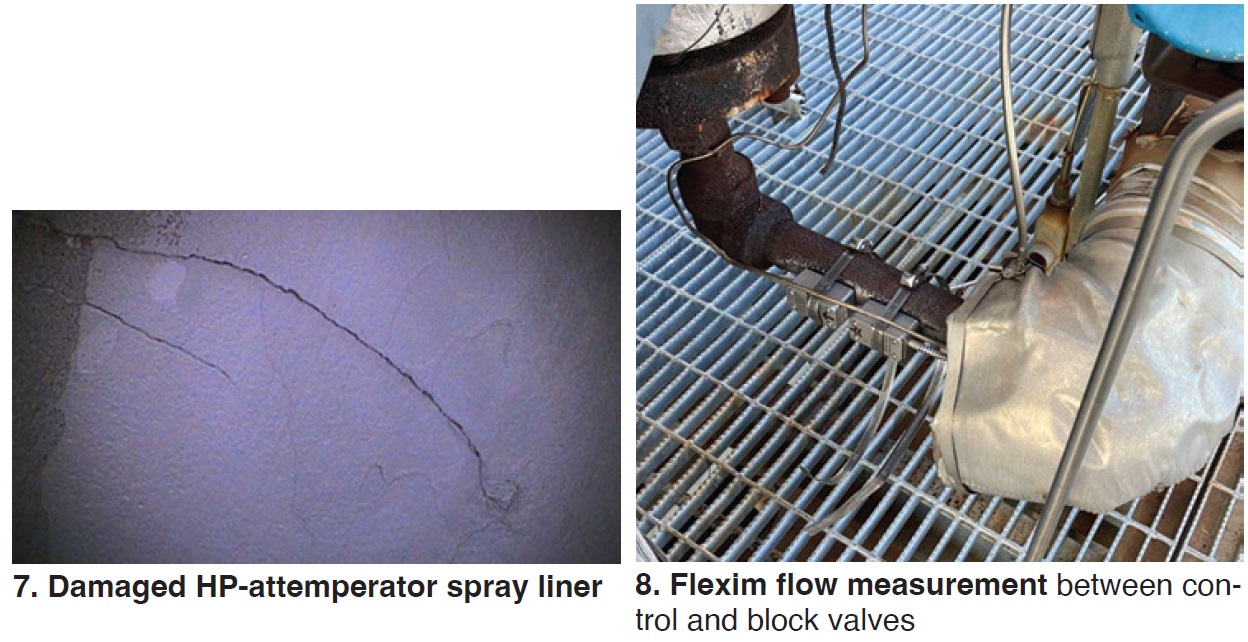
Claus Weihermueller, Flexim Singapore, presented Attemperator leak detection to prevent steam tube damage. To get more detail, access the summary of Flexim’s Denis Funk presentation at the 2023 HRSG Forum (CCJ No. 77, p 73).
Weihermueller’s update on this non-invasive flow monitoring solution highlighted the ease of attachment and accuracy of the meters.
One feature presented was its application on an HRSG spraywater line between the control and block valves (Fig 8), identified as “a challenging spot.”
Monitoring equipment under pressure
Wayne Hill, Energy Australia, discussed Implementation of a software package for tracking pressure equipment maintenance, identified as an inspection-data management system (IDMS) for boiler tubing, HEP, and condensers.
The basics include tracking failure mechanisms with graphical maps, using data to help formulate future outage work, and centralizing and storing equipment history.
One result shown was a graphical boiler-tube inspection, failure, and repair database. The HEP module included inspections, repairs, and hanger surveys. The program’s condenser module includes history, tube status, consistent tube numbering, and failure predictions.
Low-load operation
Alan Beveridge, Alinta Energy Australia, offered The effects of boiler low-load operation on evaporator (waterwall) tubes and first-stage superheater tubes, analyzing the impact of low-load operation on flow disturbances.
“Operation of [fossil] power boilers at low loads requires consideration of the effects of buoyancy and steam quality on flow stability, which in turn affects tube metal temperatures and tube life,” he explained. Buoyancy is the ratio of steam volume to water volume, and steam quality is the ratio of steam to water. “These issues are complex and dependent on boiler design,” he stated.
Beveridge covered tube temperature versus steam quality and heat flux and the influence of tube slope, among other specifics, including headers and distribution pipes.
The basic message, “Low-load operation increases the likelihood of flow instability and localized temperature changes. Analysis of flow patterns can assist in the optimization of inspection and repairs, and reduce failures.”
Dooley added that “This may be applied to better understand overheating failure of sloping waterwall tubes at a corner door offset that has occurred in a conventional boiler.”
Swanbank, Pelican Point
Swanbank E, discussed at previous ABHUG meetings, is a 385-MW combined cycle in Queensland with Alstom GT26 gas turbine and 145-MW steam turbine behind a triple-pressure HRSG. The aging HRSG was designed for baseload operation, but daily thermal cycling has led to degradation of insulation material, casing cracks in the transition duct and SH1 section, and general concerns with HRSG structural integrity because of its exposure to high temperature. Swanbank E, owned and operated by CleanCo Queensland, was commissioned in 2002.
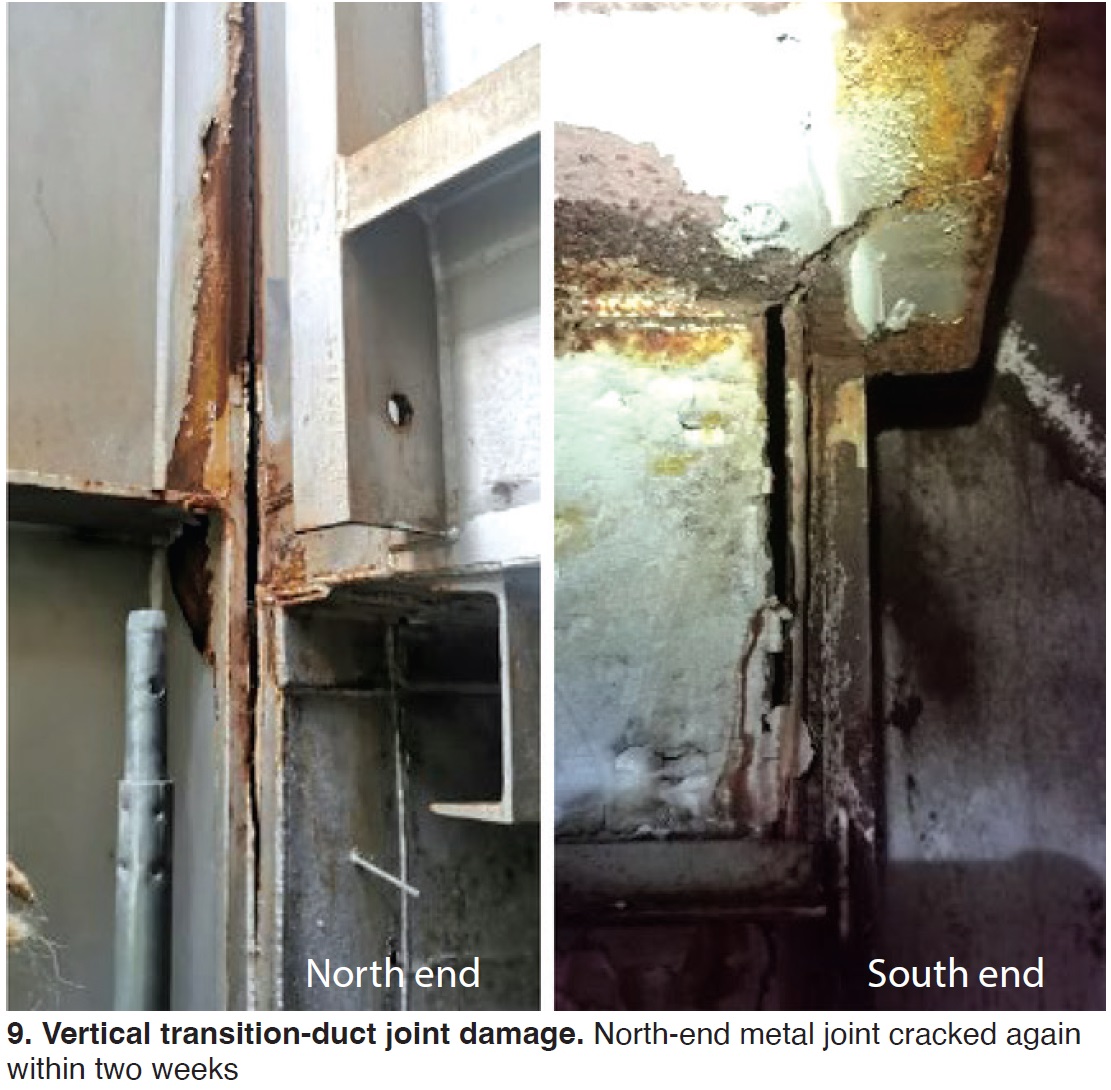
Problem areas, presented by Brad Kreis and Flower Hua, include vertical transition duct-to-HRSG joints (Fig 9) and metal expansion joints (now replaced with fabric). Discussions centered around options and challenges including repair difficulties (both inside and outside), congested work areas, and excessive scaffolding needs. Participants shared their experiences and ideas.
Kevin Crowley, Engie, also discussed high cycling and HRSG inspections and findings at Pelican Point in Adelaide, South Australia, commissioned in 2001. This 485-MW station has two GT13E2 gas turbines, one steam turbine and two unfired HRSGs.
The station now serves morning and evening peak demands; gas-turbine starts are increasing annually. Monthly starts peaked in March 2023.
Some of the more graphic examples shown included economizer tube repair (Fig 10), main steam slide support disengagement (Fig 11), and a planned bypass stack installation to run a gas turbine in open cycle, reduce thermal stresses on an HRSG, and allow HRSG maintenance (Fig 12).
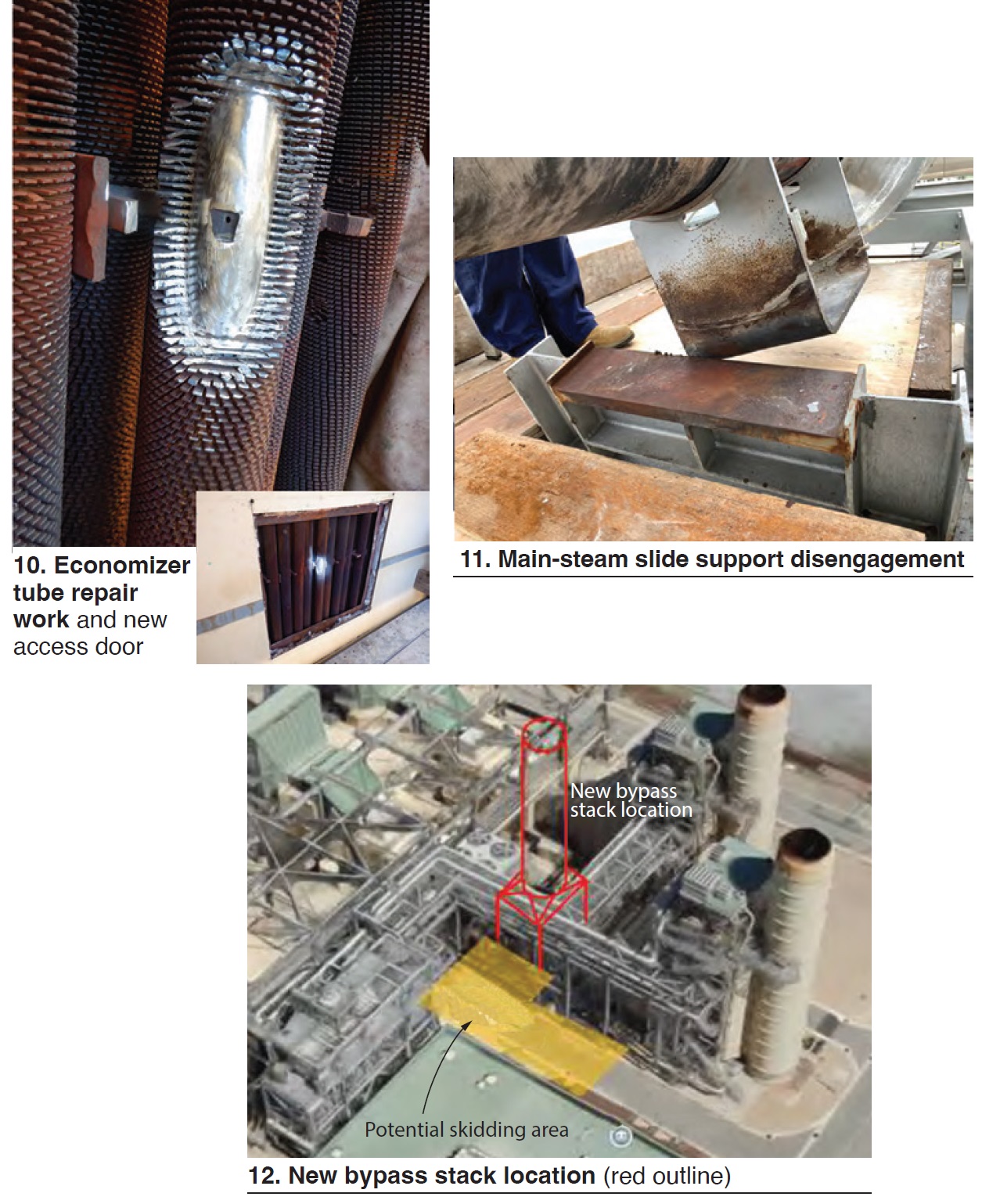
Rounding it out
Other technical presentations included these:
- Update on detecting and neutralizing hexavalent chromium, by David Addison, which will be revised again for the 2024 HRSG Forum, June 10 – 13, in St Louis, Mo.
- Boiler chemical cleaning (ALG Australia).
- Improving reliability of degassed conductivity and cation exchange measurement using EDI technology (Swan).
- Tube rMW boiler (PEI New Zealand).
- FAC in a 50-year-old boiler (HRL).
- Creep fatigue life assessment and weld risk ranking of P91 HP piping system (Quest Integrity).
- HRSG tube failures in superheater and evaporator circuits (Quest Integrity).
- Cycle-chemistry updates at Loy Yang B.
- Cycle chemistry at Kogan Creek (CS Energy).
- Mobile reporting (Intertek and TransAlta Canada).
- Updates on activities at IAPWS, AUSAPWS, and NZAPWS.
Exhibitors/service providers
The meeting featured six exhibitors/supporters: Duff and Macintosh with Sentry, Flotech, HRL, Intertek, Precision Iceblast Corp, and Swan.
- The Duff & Macintosh/Sentry team, provides electronic and mechanical instrumentation to customers in Australia, New Zealand, Asia Pacific, and Antarctica for power stations, research facilities, pharmaceutical research, and defense organizations.
- Flotech Controls supplies severe-service valves and instrumentation to all industry sectors throughout Australia, New Zealand, and the Asia Pacific Region.
- HRL Technology Group is a leading energy consulting organization specialized in engineering, testing and laboratory services.
- Intertek provides technical inspection services, asset-integrity management programs, and nondestructive testing to power generation, oil and gas, and other major industries.
- Precision Iceblast Corp says it is the most experienced dry ice blasting company in the world. It specializes in HRSG deep-cleaning technologies.
- Swan Analytical Instruments provides high quality instrumentation for boiler and water system operation and analysis.



